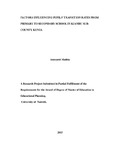| dc.description.abstract | The purpose of the study was to establish factors influencing pupils’ transition rates from
primary to secondary school in Kiambu Sub-County, Kenya. The study was guided by
three research objectives. Research objective one sought to assess whether parental level
of education influence pupils’ transition rates from primary to secondary school, research
objective two sought to establish whether cost of education influence pupils’ transition
rates from primary to secondary school while research objective three sought to assess
whether pupils` home background influence pupils’ transition rates from primary to
secondary school in Kiambu Sub-County. Descriptive survey design was used because it
enabled the researcher to gather information concerning factors influencing pupils’
transition rates from primary to secondary school in Kiambu Sub-County. The study was
based on systems theory (1968) .The questionnaire were issued to a size of 13 head
teachers, 28 class teachers ,649 pupils from 13 public primary schools while quantitative
data was analyzed through descriptive statistics. The findings revealed that parental level
of education influence pupils’ transition rates from primary to secondary school which
shows that parent’s level of education had a lot of impact on schooling of children
because the more educated parents were the more they were likely to enroll their children
and push them through school. The study also revealed that high academic attainment of
parents significantly reduce chances of primary school dropout. The cost of secondary
education was very high. This was because parents were required to meet some
operational costs such as maintenance and may be required to pay for many other things
including food, uniforms, learning materials, boarding fee, medical care and special
equipment. Direct cost was too high for parents as indicated by eight(61.5%) of head
teachers and inability of the poor to meet education costs for all their children was a
barrier to education as indicated by eight(61.5%) of head teachers. The study concluded
that parental level of education influenced pupils’ transition rates from primary to
secondary school. It was also concluded that high academic attainment of parents
significantly reduced chances of primary school dropout. It was also concluded that
pupils from lower income background do not make a successful transition to postprimary
school, and that parents from good economic background motivates their
children to attend educational programs. It was also concluded that the major challenge
to access of secondary education was that parents were not able to meet some
operational costs for secondary education. The study lastly concluded that direct cost
was too high for parents and inability of the poor to meet education costs for all their
children was a barrier to education. In the light of the research findings, the researcher
recommended that the government should make proper decisions on measures required
for maximum pupils’ transition rates in the secondary school. The head teachers should
involve all the stakeholders in addressing the issues of non-access to secondary schools
and come up with ways of addressing the issue of transition. The researcher suggests that
since the study was based on one area, similar studies to be conducted in larger areas to
compare the results. | en_US |

